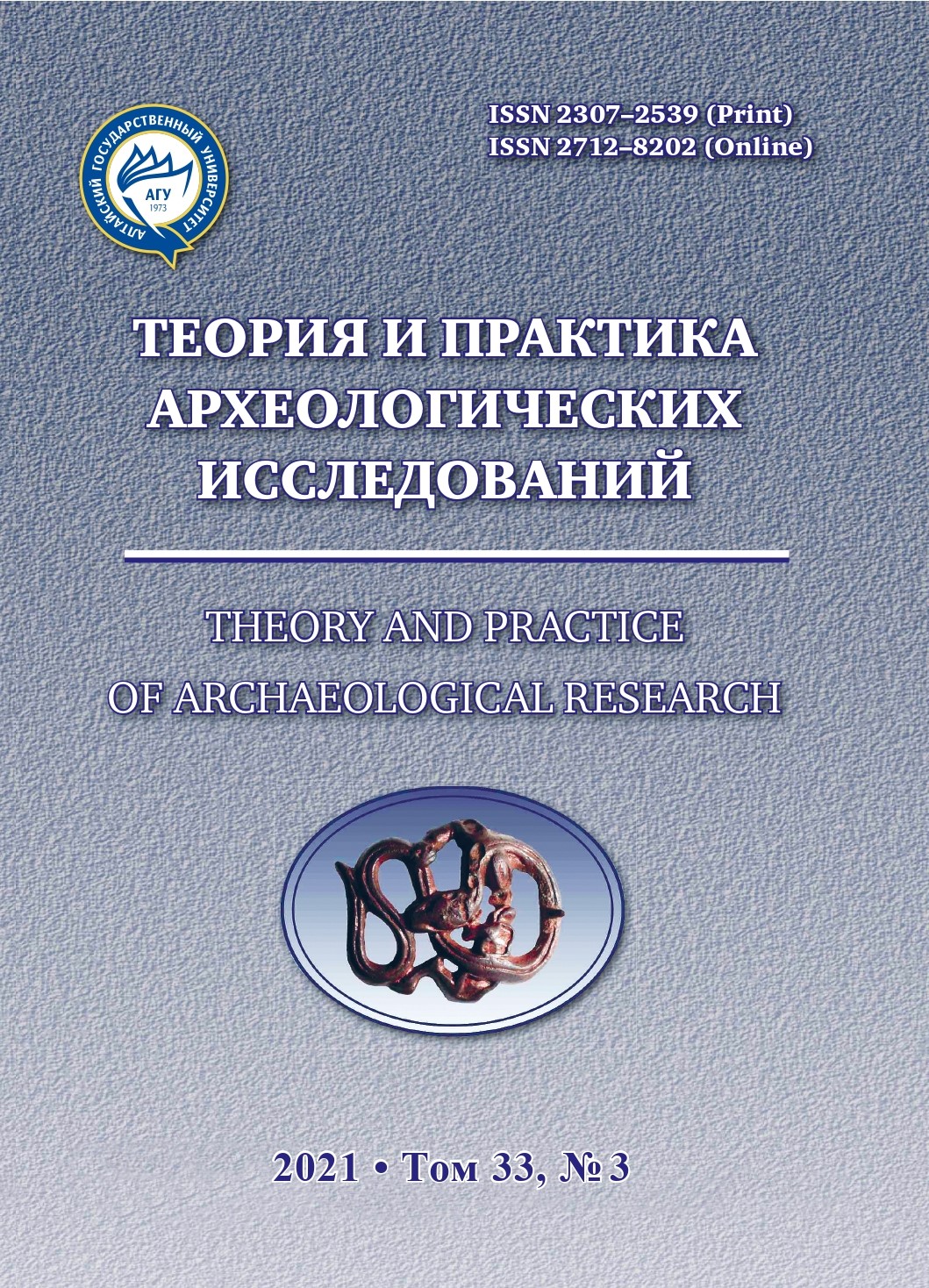ПРЕИМУЩЕСТВА АНАЛИЗА ПОСЛЕДОВАТЕЛЬНОСТИ СКОЛОВ ПРИ ИЗУЧЕНИИ ПАЛЕОЛИТИЧЕСКИХ НУКЛЕУСОВ
Аннотация
Анализ последовательности сколов является одним из основных компонентов технологического анализа. Этот анализ обычно применяется для реконструкции технологической последовательности бифасиальных орудий среднего и верхнего палеолита. Помимо бифасиальных орудий, анализ последовательности сколов применялся к геометрическим микролитам и макроорудиям, изготовленным на крупных отщепах, таким как скребки кина. Однако потенциал этого анализа гораздо шире. В предлагаемой вниманию читателей статье мы представляем основные подходы и алгоритм применения анализа последовательности сколов для анализа палеолитических нуклеусов.
Алгоритм анализа включает пять основных шагов: определение направлений всех негативов сколов на артефакте, определение взаимной последовательности соседних негативов сколов, объединение негативов в «технологические единицы», определение взаимной последовательности групп объединенных негативов и создание финальной схемы. В качестве примера приведен анализ последовательности сколов на двух кареноидных нуклеусах из комплексов кульбулакской культуры (западная часть Центральной Азии). Анализ последовательности сколов, примененный для реконструкции технологических последовательностей нуклеусов, лишен недостатков, присущих этому анализу применительно к бифасиальным орудиям. Авторы считают, что анализ последовательности сколов является наиболее перспективным в реконструкции палеолитических технологий первичного расщепления.
Скачивания
Metrics
Литература
Bar-Yosef O., Van Peer P. The Chaine Operatoire Approach in Middle Paleolithic Archaeology. Current Anthropology. 2009. № 1 (50). Рp. 103–131.
Boёda E. Determination des unitйs techno-fonctionnelles des piиces bifaciales provenant de la couche acheulйenne C’3 base du site de Barbas I // Les industries а outils bifaciaux du Paléolithique moyen d’Europe occidentale. Liиge : Editions de l’Universitй de Liиge 2001. Pp. 51–75.
Boёda E., Geneste J. M., Meignen L. Identification de сhaine opйratoires lithiques du Paléolithique ancien et moyen // Paléo. 1990. № 2. Рp. 43–80. Chabai V. P. Srednij paleolit Kryma [Middle Paleolithic of Crimea]. Simferopol : Shlyah, 2004. 324 p. (In Russ.)
Clarkson C., Vinicius L., Lahr M. M. Quantifying Flake Scar Patterning on Cores Using 3D Recording Techniques // Journal of Archaeological Science. 2006. № 33. Pp. 132–142.
Girya E. Yu. Tehnologicheskij analiz kamennyh industrij: Metodika mikro-makroanaliza drevnih orudij truda. Ch. 2 [Technological Analysis of Stone Industries (Methodology of micro-macroanalysis of Ancient Tools, Part 2). Sankt-Peterburg : Izd-vo IIMK RAN, 1997. С. 199 (In Russ.)
Doronichev V. B. Izuchenie tehniki rasshchepleniya nukleusov kak sistemy vzaimosvyazannyh teknologicheskih processov (po materialam Abadzehskogo mestonahozhdeniya v Majkopskom rajone) [Studying the Technique of Splitting Cores as a System of Interrelated Technological Processes (based on materials from the Abadzekh site in the Maikop region)]. Voprosy arheologii Adygei. [Questions of Archaeology of Adygea]. Majkop : Adygejskoe knizhnoe izdatel’stvo, 1986. Pp. 79–92 (In Russ.)
Inizan M. L., Reduron-Ballinger M., Roche G., Tixier J. Technology and Terminology of Knapped Stone. Translated by J. Fйblot-Augustins. Prйhistoire de la Pierre Taillйe T. 5. Nanterre : CREP, 1999. P. 189
Jцris O. Neue Untersuchungen zum Mittelpalдolithikum von Buhlen, Hessen. Technologische Studien zur Pradniktechnik in Horizont IIIb des Oberen Fundplatzes // Ethnographisch Archдologische Zeitschrift. 1994. № 35. Рp. 88–97.
Jцris O. Bifacially backed knives (Keilmesser) in the Central European Middle Palaeolithic // Axe age: Acheulian Tool-Making from Quarry to Discard / eds. by N. Goren-Inbar, G. Sharon. London, 2006. Pp. 287–310.
Kolobova K. A. Priemy oformleniya kamennyh orudij v paleoliticheskih industriyah Gornogo Altaya [Techniques for the Formation of Stone Tools in the Paleolithic Industries of Gorny Altai]. Novosibirsk : Izd-vo In-ta arheologii i etnografii SO RAN, 2006. (In Russ.)
Kolobova K. A., Krivoshapkin A. I., Shnaider S. V. Early Geometric Microlith Technology In Central Asia // Archaeological and Anthropological Sciences. 2018. №1. DOI: 10.1007/s12520-018-0613-y
Kolobova K. A., Shalagina A. V., Chistyakov P. V., Bocharova E. N., Krivoshapkin A. I. Threedimensional Modelling Application for Studying Stone Age Assemblages // Siberian Historical Research. 2020. № 4. Pp. 240–260. DOI: 10.17223/2312461X/30/12
Kot M. A. The Earliest Middle Palaeolithic Bifacial Leafpoints in Central and Southern Europe. Technological Approach. PhD Thesis. Warsaw. 2013. Р. 374
Kot M. A. The Earliest Middle Palaeolithic Bifacial Leafpoints in Central and Southern Europe: Technological Approach // Quaternary International. 2014. № 326–327. Р. 381–397. DOI: 10.1016/j.quaint.2013.10.030
Lemorini С., Bourguignon L., Zupancich A., Gopher A., Barkai R. A Scraper’s Life History: Morpho-Techno-Functional and Use-Wear Analysis of Quina and Demi-Quina Scrapers from Qesem Cave, Israel // Quaternary International. 2015. № 398. Рp. 1–8.
Lyubin V. P. K voprosu o metodike izucheniya nizhnepaleoliticheskih kamennyh orudij [On the Question of the Method of Studying the Lower Paleolithic Stone Tools]. Paleolit I neolit SSSR [Paleolithic and Neolithic of the USSR]. Vol. V. Moscow; Leningrad : Nauka, 1965. Pp. 7–75 (In Russ.)
Nehoroshev P. E. Tehnologicheskij metod izucheniya pervichnogo rasshchepleniya kamnya srednego paleolita [Technological Method for Studying the Primary Cleavage of the Middle Paleolithic Stone]. Sankt-Peterburg : Evropeiskij dom, 1999. P. 172. (In Russ.)
Neruda P. Blank Length Reconstruction on the Base of Circular Segment Method –Core Refitting Case Study // Anthropologie (Brno). 2015. № 53 (3). Рp. 531–545.
Nerudova Z., Neruda P. Technology of Moravian Early Szeletian Leaf Point Shaping: A Case Study of Refittings from Moravský Krumlov IV Open-Air Site (Czech Republic) // Quaternary International. 2017. № 428. Рp. 91–108. DOI: 10.1016/j.quaint.2015.09.065
Ocherednoj A. K. Sistemy skalyvaniya v analize izgotovleniya dvustoronneobrabotannyh orudij [Chipping Systems in the Analysis of the Manufacture of Double-Sided Tools]. Trudy istoricheskogo fakul’teta Sankt-Peterburgskogo universiteta [Proceedings of the Faculty of History of St. Petersburg University]. 2014. № 18. Рp. 215–224. (In Russ.)
Pastoors A. Standardization and Individuality in the Production Process of Bifacial Tools — Leaf-Shaped Scrapers from the Middle Paleolithic Open Air Site Sare Kaya I (Crimea). In Neanderthals and Modern Humans — Discussing the Transition. Central and Eastern Europe from 50.000–30.000 B. P. Mettmann : Neanderthal Museum, 2000. Рp. 243–255.
Pastoors A., Schafer J. Analyse des йtats techniques de transformation d’utilisation et états post dépositionnels. Illustrée par un outil bifacial de Salzgitter-Lebenstedt (FRG) // Préhistoire Européenne. 1999. № 14. Рp. 33–47.
Pavlenok G. D., Kozlikin M. B., Shunkov M. V. Small Blade Technology in the Early Upper Paleolithic Industries from Denisova Cave: Data from Analysis of a Lithic Reduction Sequence // Ural’skij Istoriceskij Vestnik. 2021. № 70 (1). Pp. 123–128
Pavlenok K. K., Belousova N. E., Rybin E. P. Atributivnyj podhod k rekonstrukcii “operacionnyh cepochek” rasshchepleniya kamnya [An Attributive Approach to the Reconstruction of “Operational Chains” of Stone Splitting]. Vestnik Novosibirskogo gosudarstvennogo universiteta. Ser.: Istoriya, filologiya [Bulletin of Novosibirsk State University Series: History, Philology]. 2011. Vol. 10. Issue 3. 2011. P. 35–46. (In Russ.)
Pavlenok G., Pavlenok K. Scar-Pattern Analysis of the Bladelet Cores from Layer 23 of Kulbulak Site // The Past has a Future! Conference to Mark the Centenary of Archaeology at the Institute of Archaeology, University of Warsaw (9–3.12.2019). Warsaw, 2019. Pp. 61–62.
Pelegrin J. Prehistoric Lithic Technology: Some Aspects of Research // Archaeological Review from Cambridge. 1990. № 9. Рp. 116–125.
Pigeot N. Reflexions sur l’histoire technique de l’homme: De l’evolution cognitive a l’evolution culturelle // Paleo 1991. № 3. Рp. 167–200.
Richter J. Une analyse standarisée des chaines opératoires sur les pièces foliacées du Paleolithique moyen tardif // L. Bourgignon, I. Ortega and M.‑C. Frèresautot (eds). Préhistoire et approche expérimentale. 2001. Рp. 77–78.
Richter J. Copies of flakes: Operational Sequences of Foliate Pieces from Buran-Kaya III Level B1 // V. P. Chabai, K. Monigal and A. E. Marks (eds.). The Middle Paleolithic and Early Upper Paleolithic of Eastern Crimea 3. Liege : ERAUL 104, 2004. Рp. 233–247.
Shalagina A. V., Kharevich V. M., Maury S., Baumann M., Krivoshapkin A. I., Kolobova K. A. Reconstruction of the Bifacial Technological Sequence in Chagyrskaya Cave Assemblage // Siberian Historical Research. 2020. № 3. Рp. 130–151. DOI: 10.17223/2312461X/29/9
Shalagina, A., Kolobova, K., Krivoshapkin, A. Scar Pattern Analysis as a Method for the Rreconstruction of Lithic Artifacts Production Sequence // Stratum Plus. 2019. № 1. Рp. 145–154.
Shalagina A. V., Krivoshapkin A. I., Kolobova K. A. Truncated-Faceted Pieces in the Paleolithic of Nothern Asia. Archaeology, Ethnology & Anthropology of Eurasia. 2015. № 4(44). Р. 33–45. DOI: 10.17746/1563-0102.2015.43.4.033-045
Soriano S., Villa P. Early Levallois and the Beginning of the Middle Paleolithic in Central Italy // PLoS One. 2017. № 12(10). e0186082. DOI:10.1371/journal.pone.0186082.
Scheer A.‑W. ARIS — Modellierungsmethoden, Metamodelle, Anwendungen. Berlin Heidelberg : Springer-Verlag. 1998. DOI 10.1007/978-3-642-97731-2
Soriano S., Villa P., Delagnes A., Degano I., Pollarolo L., Lucejko J. J., Henshilwood Ch., Wadley L. The Still Bay and Howiesons Poort at Sibudu and Blombos: Understanding Middle Stone Age Technologies // PloS ONE. 2015. № 10 (7). Р. 1–46.
Uthmeier Th. The Transition from Middle- to Upper Palaeolithic at Buran Kaya III, Crimea (Ukraine): a Case of Conceptual Continuity of Lithic Artefact Manufacture?» // A. Pastoors and M. Peresani (eds.). Flakes not Blades: The Role of Flake Production at the Onset of the Upper Palaeolithic. Mettmann: Wissenschaftliche Schriften des Neanderthal Museums 5, 2012. Рp. 239–260.
Uthmeier Th. Transformation Analysis and the Reconstruction of On-Site and Off-Site Activities: Methodological Remarks // V.P. Chabai, K. Monigal and A.E. Marks (eds.): The Middle Paleolithic and Early Upper Paleolithic of Eastern Crimea: The Paleolithic of Crimea III. Liege : ERAUL 104, 2004. Рp. 175–191.
Veselsky A. P. Kabazi V: Production and Rejuvenation of Bifacial Tools // Kabazi V: Interstratification of Micoquian & Levallois-Mousterian Camp Sites. Palaeolithic Sites of Crimea. Vol. 3, Part 2. Simferopol; Cologne : Shlyakh, 2008. Pp. 455–479.
Wiśniewski A., Chłoń M., Weiss M., Pyżewicz K. Migal W. On Making of Micoquian Bifacial Backed Tools at Pietraszyn 49a, SW Poland // Journal of Paleolithic Archaeology. 2020. №3. Рp. 856–888.
Zwyns N. Laminar Technology and the Onset of the Upper Paleolithic in the Altai, Siberia (Studies in Human Evolution). Doctoral Thesis, Leiden : University Press. 2012. P. 414.
Авторы, публикующиеся в данном журнале, соглашаются со следующими условиями:
a. Авторы сохраняют за собой права на авторство своей работы и предоставляют журналу право первой публикации этой работы с правом после публикации распространять работу на условиях лицензии Creative Commons Attribution License, которая позволяет другим лицам свободно распространять опубликованную работу с обязательной ссылокой на авторов оригинальной работы и оригинальную публикацию в этом журнале.
b. Авторы сохраняют право заключать отдельные договора на неэксклюзивное распространение работы в том виде, в котором она была опубликована этим журналом (например, размещать работу в электронном архиве учреждения или публиковать в составе монографии), с условием сохраниения ссылки на оригинальную публикацию в этом журнале. с. Политика журнала разрешает и поощряет размещение авторами в сети Интернет (например в институтском хранилище или на персональном сайте) рукописи работы как до ее подачи в редакцию, так и во время ее редакционной обработки, так как это способствует продуктивной научной дискуссии и положительно сказывается на оперативности и динамике цитирования статьи








2.jpg)



